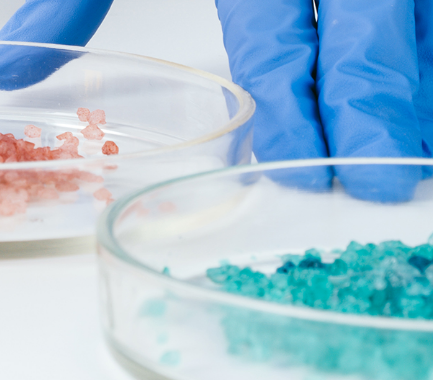Your contact
PENPET-Team - Hamburg

Laurens Rogowski
Sales
Tel. +49 (0) 40 - 675 7 99 80
sales@penpet.de
Get in touch with us.
Dimethyl terephthalate (DMT)
Dimethyl terephthalate (DMT) is an organic compound from the dicarboxylic acid ester substance class, which is of great importance to the chemical industry as a starting material for the production of polymer plastics. On an industrial scale, the substance is mainly obtained from xylene isomers in a multi-stage process of oxidation and esterification. Alternatively, dimethyl terephthalate is also produced by the direct esterification of terephthalic acid with methanol. The compound occurs naturally in some plants and fungal cultures.
In the plastics industry, the compound is used as a base material for the production of various plastic polyesters such as polyethylene terephthalate (PET), polybutylene terephthalate (PBT) or polytrimethylene terephthalate (PTT). Dimethyl terephthalate is also an important raw material for industrially manufactured polyester resins, which are used in the manufacture of paints, films and adhesives. In addition, the substance is an intermediate product for organic syntheses in the chemical industry, which can be converted into 1,4-cyclohexanedimethanol by hydrogenation, among other things.
At PENPET you get dimethyl terephthalate (DMT) of the highest quality - from a reliable partner who will also meet your requirements in the long term. We look forward to receiving your inquiry for an individual offer. Prompt delivery of the solid can be made in packages with different weights.
CAS no. 120-61-6
EINECS no. 204-411-8
Molecular formula: C10H10O4
Synonyms: DMT, dimethyl terephthalate, dimethyl p-phthalate, dimethyl 1,4-benzenedicarboxylate, dimethyl benzene-1,4-dicarboxylate
Areas of application: Starting material for chemical syntheses and for the production of polymer plastics
More information
A diester of terephthalic acid, dimethyl terephthalate (DMT) is an aromatic compound with a six-carbon cyclic structure at its core. Due to this unsaturated phenyl ring, the substance is suitable for addition reactions and can, among other things, be easily hydrogenated. The two ester groups of the compound, which replace the carboxyl groups of terephthalic acid and are each connected to a methyl radical, are located on two opposite carbon atoms of the ring structure. By transesterifying these functional groups, dimethyl terephthalate can be converted into other esters and become the starting material for polyester formation.
Under normal conditions, dimethyl terephthalate (DMT) is a colorless solid with no appreciable intrinsic odor present in the form of crystalline flakes or flakes. The compound has a high thermal resistance and only melts when heated to 141 °C. Liquid dimethyl terephthalate converts to the gaseous state at temperatures above 288 °C.
The substance is practically insoluble in water and some organic solvents such as methanol and ethanol at room temperature. On the other hand, dimethyl terephthalate is easily soluble in diethyl ether, dioxane and chloroform. Due to its high density, dimethyl terephthalate will settle to the bottom of the vessel in water, both in solid form and as a hot liquid.
Dimethyl terephthalate (DMT) is a chemically stable solid that does not change its consistency even with large temperature fluctuations. However, the substance can react with strong acids, strong oxidizing agents, bases and nitrates in a dangerous manner and with high temperature generation.
The compound is difficult to ignite, but is combustible. When handling open containers of the solid, it should be noted that the fine dust from dimethyl terephthalate can be whirled up to form explosive dust-air mixtures. When processing the compound, a sufficient distance to possible sources of ignition such as open flames, strongly heated surfaces, mechanically generated sparks and electrostatically charged devices must therefore be ensured. Combustion of the substance leads to the formation of irritant and harmful gases. Among other things, large amounts of carbon dioxide and carbon monoxide can be produced.
According to the GHS classification, dimethyl terephthalate (DMT) is not classified as a hazardous substance, but it does have slightly irritating properties. If the compound comes into contact with the eye, redness and conjunctivitis may occur, partly due to the mechanical action of the solid under the eyelids. The eye should be immediately rinsed under running water and then examined by an ophthalmologist. No acute skin irritations are to be expected after exposure, but allergic reactions are possible. If symptoms occur, medical treatment should also be arranged. Contaminated parts of the body can be cleaned of residues of the substance with soap and water.
Inhaling dust from the solid or vapors and aerosols from the heated liquid can cause irritation of the respiratory tract, coughing, difficulty breathing and bronchitis. If the substance is swallowed, gastrointestinal symptoms such as abdominal pain, nausea, vomiting and diarrhea can occur in addition to irritation of the mucous membranes. Orally ingested dimethyl terephthalate should be spat out if possible. Drink water afterwards to reduce possible symptoms. The absorption of the compound into the metabolism can lead to metabolic disorders and the formation of concretion and inflammation in the urinary tract. Therefore, if poisoning with dimethyl terephthalate is suspected, seek medical attention.
The compound can damage aquatic organisms and is considered to be slightly hazardous to water. Dimethyl terephthalate should therefore not get into the ground, water bodies or wastewater. The escape of larger quantities of the substance into the environment must be reported to the local authorities. The compound is not subject to any special transport regulations.
